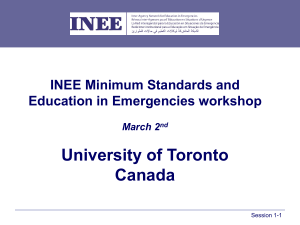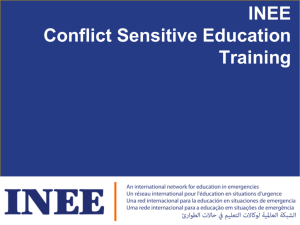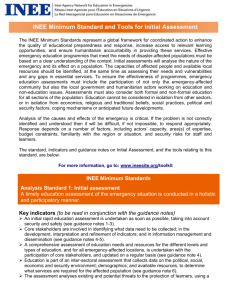Purpose of INEE Minimum Standards Questionnaire: This
advertisement
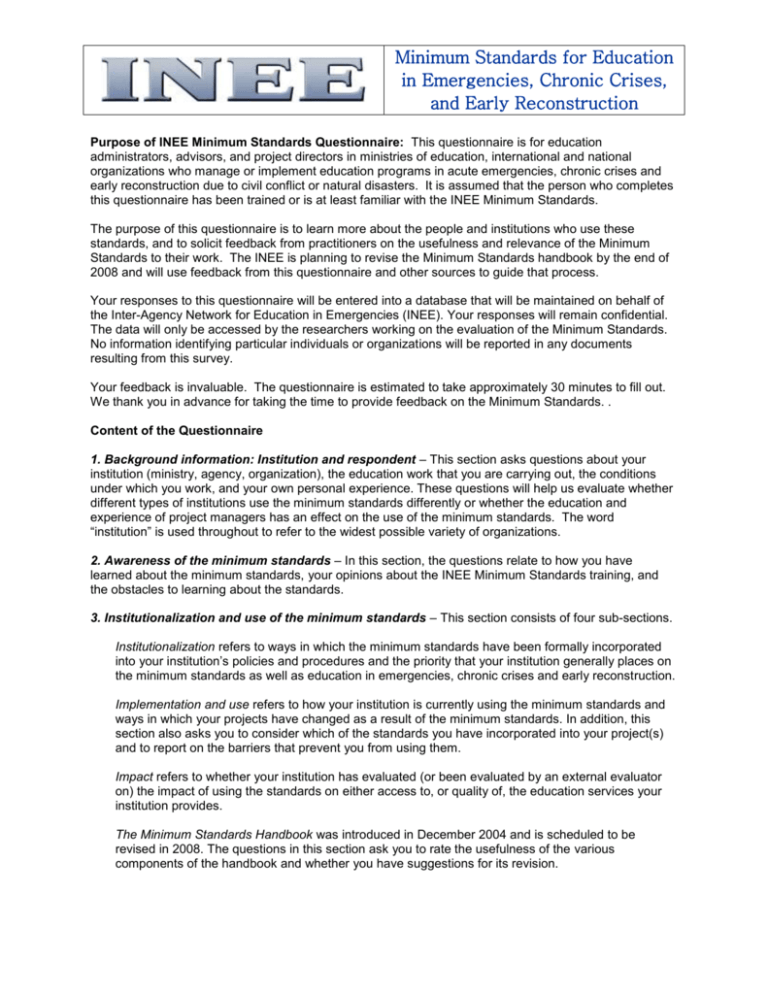
Minimum Standards for Education in Emergencies, Chronic Crises, and Early Reconstruction Purpose of INEE Minimum Standards Questionnaire: This questionnaire is for education administrators, advisors, and project directors in ministries of education, international and national organizations who manage or implement education programs in acute emergencies, chronic crises and early reconstruction due to civil conflict or natural disasters. It is assumed that the person who completes this questionnaire has been trained or is at least familiar with the INEE Minimum Standards. The purpose of this questionnaire is to learn more about the people and institutions who use these standards, and to solicit feedback from practitioners on the usefulness and relevance of the Minimum Standards to their work. The INEE is planning to revise the Minimum Standards handbook by the end of 2008 and will use feedback from this questionnaire and other sources to guide that process. Your responses to this questionnaire will be entered into a database that will be maintained on behalf of the Inter-Agency Network for Education in Emergencies (INEE). Your responses will remain confidential. The data will only be accessed by the researchers working on the evaluation of the Minimum Standards. No information identifying particular individuals or organizations will be reported in any documents resulting from this survey. Your feedback is invaluable. The questionnaire is estimated to take approximately 30 minutes to fill out. We thank you in advance for taking the time to provide feedback on the Minimum Standards. . Content of the Questionnaire 1. Background information: Institution and respondent – This section asks questions about your institution (ministry, agency, organization), the education work that you are carrying out, the conditions under which you work, and your own personal experience. These questions will help us evaluate whether different types of institutions use the minimum standards differently or whether the education and experience of project managers has an effect on the use of the minimum standards. The word “institution” is used throughout to refer to the widest possible variety of organizations. 2. Awareness of the minimum standards – In this section, the questions relate to how you have learned about the minimum standards, your opinions about the INEE Minimum Standards training, and the obstacles to learning about the standards. 3. Institutionalization and use of the minimum standards – This section consists of four sub-sections. Institutionalization refers to ways in which the minimum standards have been formally incorporated into your institution’s policies and procedures and the priority that your institution generally places on the minimum standards as well as education in emergencies, chronic crises and early reconstruction. Implementation and use refers to how your institution is currently using the minimum standards and ways in which your projects have changed as a result of the minimum standards. In addition, this section also asks you to consider which of the standards you have incorporated into your project(s) and to report on the barriers that prevent you from using them. Impact refers to whether your institution has evaluated (or been evaluated by an external evaluator on) the impact of using the standards on either access to, or quality of, the education services your institution provides. The Minimum Standards Handbook was introduced in December 2004 and is scheduled to be revised in 2008. The questions in this section ask you to rate the usefulness of the various components of the handbook and whether you have suggestions for its revision. Instructions: Please check the option that corresponds to your answer. If your answer is not listed among the responses, check “other” and enter your response in the area to the right. Please note only one response per question unless otherwise noted. Note: Questions that ask specifically about “you” refer to you as an individual, not to your organization or institution. I. Background information: Institution and respondent Institution 1. Institution name: 2. Type of institution: National NGO (includes all types of local civil society organizations) Government International NGO UN Agency Bilateral Donor (such as USAID, Danida, JICA, etc.) Foundation Other (specify): 3. Name of the country(ies)/region(s) in which you work: (please separate each country listed with a “;”) The following questions are for headquarters or central office staff. If you do not work in the headquarters, or main office of your institution, please go to question number 7. Questions for headquarters or central office staff: 4. How many employees work for your institution (national and international staff, worldwide, if applicable): 5. What is the annual budget of your institution, worldwide? $ 6. What is your institution’s annual budget for education, worldwide? $ Headquarters staff of UN agencies or international NGOs, please go to question 10. 7. What is the annual budget for education for your office, division or operating unit (the office where you work, e.g., field or district office)? $ 8. How many staff are employed in the office, division or operating unit in which you work? 9. How many of these staff members work on education project(s)? 10. Name of education project(s) on which you work: (please separate each project listed with a ‘;’) 11. If you are working in a country or sub-national office, list the in-country locations of the project(s) listed in question 10 (if you work in multiple locations, please list all and separate with a “;”). INEE Minimum Standards Questionnaire 2 12. How would you characterize the context in which you work? Please mark all that apply. Conflict Natural disaster Emergency / acute crisis Chronic crisis Post-crisis /early reconstruction Other (specify): 13. If you work in a natural disaster-affected area, which type(s) of disaster(s)? Please mark all that apply. Earthquake Tsunami Hurricane Flood Volcanic eruption Drought Other (specify): 14. What ages are targeted in your education project(s)? Please mark all that apply. Children 5 or under Children 6-11 Children 12-14 Adolescents 15-17 Young adults 18-25 Adults 26 or over 15. What is the gender of your target population(s)? Female Male Both 16. How would you characterize your target population? Displaced Not displaced Both 17. If the target population is displaced, how would you best describe their displacement? Mark all that apply. Internally displaced from conflict Internally displaced from natural disaster Refugee – someone displaced by conflict who has crossed an international border Returnee INEE Minimum Standards Questionnaire 3 18. What components are included in your education project(s)? Please mark all that apply. Early childhood education Primary Secondary Adult non-formal education Youth non-formal education Psychosocial Recreation Vocational education Accelerated learning School health HIV& AIDS in school Distribution of learning materials Development of learning materials PTA or SMC training Community mobilizing Teacher education, pre-service Teacher education, in-service School management training Curriculum revision MOE capacity building Education policy Life skills Peace education Landmine education School construction Post-secondary education Special education Other (specify): Respondent 19. What is your location within the organization? Headquarters Regional Office Country Office Sub-national Office Other (specify): 20. What are your key responsibilities? Please mark all that apply. Manage projects Advise Minister Train staff Monitor projects Provide technical support (e.g., curriculum design, EMIS, statistical analysis) Teach (children or adults) Evaluate project outcomes Design projects Other (specify): 21. How long have you worked for this institution? 0-3 months 4-6 months 7-12 months 13-24 months 2-4 years 5-9 years 10 years or more 22. How long have you held your current position? 0-3 months 4-6 months 7-12 months 13-24 months 2-4 years 5-9 years 10 years or more INEE Minimum Standards Questionnaire 4 23. What is the highest level of education you have completed? 24. What was your major field of study? High school Two years of university BA (or four years of university) Master’s degree Doctorate International affairs Teaching Comparative and international education Management and administration Educational administration Social work Other (specify): 25. May we contact you if additional information or clarification is required? Yes No If yes, please give contact details below. 26. Name: 27. Telephone number: 28. Email address: II. Awareness of the minimum standards 29. How did you learn about the minimum standards? Please mark all that apply. INEE training Handbook or brochure Word of mouth INEE website Job orientation Other (specify): 30. What do you think is the biggest challenge to learning about the minimum standards? Please select only one. Time constraints (no time to attend training) Trainings are inaccessible (distance) Training has not been offered in my area Resources are scarce to support training Standards are not available in my language or the language of the country in which I work Other (specify): 31. Have you been trained in using the minimum standards? Yes 32. If yes, how long was your INEE Minimum Standards training? No If no, please go to question 35. days 33. How would you rate the quality of the INEE Minimum Standards training materials? Poor Fair Good Excellent 34. How would you rate the usefulness of your training? Not at all useful Somewhat useful INEE Minimum Standards Questionnaire Useful Extremely useful 5 35. Have you conducted training on the minimum standards? Yes No If no, please go to question 40. 36. If yes, for whom? Please select all that apply. Staff from your organization Staff from one or more NGOs Staff from one or more United Nations organizations Ministry of Education (host government) counterparts (administrators) Principals, head teachers, and/or teachers employed by the MoE Members of the community in which you work (parents, elders, community leaders) Other (specify): 37. How many participants were trained (provide your best estimate of the number)? 38. What would most improve the INEE Minimum Standards training? Please select only one. More than three days to complete the training More time for participants to discuss how they are using the standards Incorporation of more practical examples of how the minimum standards are being implemented Incorporation of more real case studies or examples Available in local languages (please specify which language(s) separate each language with a “;”): Other (specify): 39. What additional suggestions do you have, if any, for improving the training of trainers outreach in order to increase the number of people who are trained in the use of the standards? Please limit your answer to the space provided. 40. Have you organized or led formal staff meetings to discuss using the standards? Yes No 41. Have you participated in staff meetings to discuss using the standards? Yes No 42. Have you, or a member of your staff, participated in an INEE Minimum Standards Training of Trainers workshop? Yes No If no, please go to question 44. 43. If yes, please specify when and where. INEE Minimum Standards Questionnaire Nairobi, Kenya, January 23-25, 2006 Bangkok, Thailand, February 14-16, 2006 Lahore, Pakistan, February 21-23, 2006 Geneva, Switzerland, March 15-17, 2006 Washington, DC, May 16-18, 2006 Dakar, Senegal, July 4-6, 2006 Amman, Jordan, September 19-21, 2006 6 III. Institutionalization and use of the minimum standards Institutionalization 44. Has education in emergencies, chronic crises or early reconstruction been incorporated into your institution? Please mark all that are relevant. Yes, it has always been part of our institution (before the Minimum Standards were written) Yes, it has been incorporated into our institutional mandate Yes, it has been identified as an institutional priority Yes, it is included in our humanitarian response team activities Yes, it is included in our institution’s strategic or annual plans Yes, it is included in our institution’s orientation manual No, it is not an institutional priority (please go to question 46) Other (specify): 45. If education in emergencies, chronic crises or early reconstruction is a priority for your institution, which two factors were most influential in this decision? Please select only two factors. We respond to specific requests for education from the people with whom we work Institutional recognition of education in emergencies as a priority The development of the minimum standards Staff training on the standards Available funding for education during humanitarian crises increased Other (specify): 46. Has your institution committed to using the minimum standards? Yes No If yes, please go to question 48. 47. If you answered “no” to question 46, why? Please mark all that apply. Institution has its own standards Institution lacks funds to use the standards Institution has no capacity or trained staff to support the implementation of the standards Education is not viewed as a priority humanitarian response Other (specify): 48. Have any of the standards been formally adopted into the policies or procedures of your organization? Yes No If no, please go to question 50. 49. If yes, please provide a specific example of a changed policy or procedure. Implementation and use 50. Are you currently using the INEE Minimum Standards in your project/program/work? Yes No If yes, please go to question 52. INEE Minimum Standards Questionnaire 7 51. If no, why not? Please mark all that apply and then proceed to question 53. They need clarification My organization has not accepted them I do not have time to use them I am not trained to use them We are concerned about replacing government standards They do not seem relevant to the current situation The standards are too high—it is unrealistic to use them They do not exist in the language we need The wording of the Minimum Standards, Indicators and Guidance Notes is not clear The concepts in the standards are difficult to translate into practice We do not have enough copies of the Handbook We do not have sufficient funding to achieve the standards Donor mandate asks us not to use them They are missing key elements (specify): Other (specify): 52. How are you using the minimum standards? Please mark all that apply. Advocacy Project design Technical guidance Assessment Report writing Reference guide Monitoring and evaluation to improve quality Disaster/emergency preparedness planning Guide to coordination Tool for increasing community participation Other (specify): 53. Have you changed a project design because of the Minimum Standards? Yes No If no, please go to question 55. 54. If yes, how? Please mark all that apply. Minimum standards incorporated into project proposal Minimum standards used as a reference when developing project implementation plan Existing project has been redesigned to incorporate minimum standards Minimum standards incorporated into work with MoE Requested additional funding in order to redesign projects to meet the minimum standards Other (specify): 55. Have you changed the way your education projects are implemented as a result of the INEE Minimum Standards? Yes No If no, please go to question 57. 56. If yes, how? Please mark all that apply. Existing projects have been re-designed to ensure that minimum standards are incorporated Minimum standards have been incorporated into monitoring and evaluation activities Other (specify): We would like to understand more about how useful each standard is and why the standards are used or not used. In the following questions, please note your responses in the space provided. 57. Which standard have you used the most? INEE Minimum Standards Questionnaire 8 58. Which standard have you used the least? 59. Which standard would you revise? 60. How would you revise it? 61. Which of the cross-cutting issues have you used in your projects? Please mark all that apply. Gender HIV/AIDS Special education needs None 62. Do you think the internet has reinforced the use of the standards? Yes No If no, please go to question 64. 63. If yes, how? Please choose all that apply. I can access information about them easily I can read about how other people use them I can send questions to the INEE Secretariat if I have them I can get copies of education toolkits that provide suggestions for how to use them I can download a copy of the standards Other (specify): 64. Will you use the Minimum Standards in the future? Yes No If no, please go to question 66. 65. If yes, how? Please choose all that apply. Design or redesign of project Improve quality of existing project Monitor and evaluate project Train and build capacity of staff or counterparts Advocate for greater access to education Improve coordination among education counterparts (government, UN, NGO, community) 66. Do you encourage your counterparts to use the minimum standards? Yes No 67. Which of your educational counterparts are aware of the minimum standards? Please mark all that apply. My counterparts who work for international NGOs are aware of the minimum standards My counterparts who work for national NGOs are aware of the minimum standards My counterparts who work for UN agencies are aware of the minimum standards My counterparts at the Ministry of Education are aware of the minimum standards Teachers and other staff in our project(s) are aware of the minimum standards Don’t know INEE Minimum Standards Questionnaire 9 68. Which of your educational counterparts have incorporated the minimum standards into their activities? Please mark all that apply. Colleagues at international NGOs Colleagues at national NGOs Colleagues at UN agencies MoE policy makers Teachers and other project staff Don’t know Impact 69. Has your institution carried out any evaluations related to the use of the standards? Yes No If no, please go to question 71. 70. If yes, please provide name(s) of study: (please separate each with a “;”) 71. Can increased enrollment in schools or education activities supported by your project (or any projects within your institution) be attributed to the use of the INEE Minimum Standards? Yes No If no, please go to question 73. 72. How do you know that the Minimum Standards have contributed to increased enrollment? Please write a one-sentence response. 73. Can you attribute any achievements in your project outcomes or improvements in the quality of educational services provided in your project (or by your institution) to the use of the INEE Minimum Standards? Yes No If no, please go to question 75. 74. In one or two sentences, briefly describe the achievements or improvements in quality associated with the use of the Minimum Standards. INEE Minimum Standards Questionnaire 10 The Minimum Standards Handbook 75. Please rate the usefulness of the content and presentation of the INEE Minimum Standards Handbook using the scale shown below. Please refer to the handbook to remind yourself of details if needed. Not at all useful Somewhat useful Useful Extremely useful Format of the handbook Standards Indicators Guidance notes Assessment framework (p. 29) Planning in an emergency: situation analysis checklist (p. 30) Information gathering and needs assessment questionnaire (p. 33) Psychosocial checklist (p. 49) School feeding programme checklist (p. 51) Teacher’s code of conduct (p. 70) Terminology annex (p. 79) References and resource guide (p. 83) 76. How could the minimum standards be improved? Please mark all that apply. Provide a simplified form of the minimum standards booklet for easy reference Continue advocacy efforts to increase awareness and use of the minimum standards Provide a set of absolute minimum standards for use in an acute emergency Provide more tools to use in implementing the standards Provide more examples of how the standards have been used in practice Fine as is; no change needed 77. Are there revisions to the minimum standards that you would like to suggest? Please limit your suggestions to no more than two lines. Thank you for completing the survey! Your feedback is invaluable. Questionnaire responses will be fed into a database system that will allow for easy entry and analysis of the information to determine dominant trends, applications, and recommendations gleaned from the questionnaires. This analysis will inform a report on the awareness, utilization, institutionalization, and as much as possible, the impact of the standards, which will be shared with INEE members and others. After you have completed this form, please save this document and email it to: Jessica Levknecht: jlevknec@gwu.edu INEE Minimum Standards Questionnaire 11
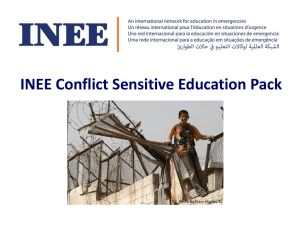
![View DRR Presentation Day 2 [PPT 774.00 KB]](http://s2.studylib.net/store/data/005450963_1-d9a539224e4e88c2b7c6d22d8b201673-300x300.png)
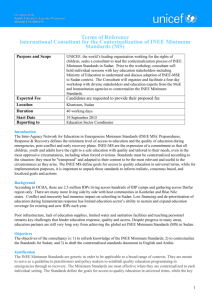


![View DRR Presentation Day 1 [PPT 1.07 MB]](http://s2.studylib.net/store/data/005562166_1-09058b36ec0804e4de33b95a0df46bfd-300x300.png)

